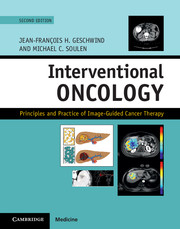Book contents
- Frontmatter
- Contents
- List of contributors
- Section I Principles of oncology
- Section II Principles of image-guided therapies
- 2 Principles of radiofrequency and microwave tumor ablation
- 3 Principles of irreversible electroporation
- 4 Principles of high-intensity focused ultrasound
- 5 Principles of tumor embolotherapy and chemoembolization
- 6 Principles of radioembolization
- 7 Principles of intra-arterial infusional chemotherapy in the treatment of liver metastases from colorectal cancer
- 8 Imaging in interventional oncology: Role of image guidance
- 9 Novel developments in MR assessment of treatment response after locoregional therapy
- Section III Organ-specific cancers – primary liver cancers
- Section IV Organ-specific cancers – liver metastases
- Section V Organ-specific cancers – extrahepatic biliary cancer
- Section VI Organ-specific cancers – renal cell carcinoma
- Section VII Organ-specific cancers – chest
- Section VIII Organ-specific cancers – musculoskeletal
- Section IX Organ-specific cancers – prostate
- Section X Specialized interventional techniques in cancer care
- Index
- References
8 - Imaging in interventional oncology: Role of image guidance
from Section II - Principles of image-guided therapies
Published online by Cambridge University Press: 05 September 2016
- Frontmatter
- Contents
- List of contributors
- Section I Principles of oncology
- Section II Principles of image-guided therapies
- 2 Principles of radiofrequency and microwave tumor ablation
- 3 Principles of irreversible electroporation
- 4 Principles of high-intensity focused ultrasound
- 5 Principles of tumor embolotherapy and chemoembolization
- 6 Principles of radioembolization
- 7 Principles of intra-arterial infusional chemotherapy in the treatment of liver metastases from colorectal cancer
- 8 Imaging in interventional oncology: Role of image guidance
- 9 Novel developments in MR assessment of treatment response after locoregional therapy
- Section III Organ-specific cancers – primary liver cancers
- Section IV Organ-specific cancers – liver metastases
- Section V Organ-specific cancers – extrahepatic biliary cancer
- Section VI Organ-specific cancers – renal cell carcinoma
- Section VII Organ-specific cancers – chest
- Section VIII Organ-specific cancers – musculoskeletal
- Section IX Organ-specific cancers – prostate
- Section X Specialized interventional techniques in cancer care
- Index
- References
Summary
Introduction
Advances in medical imaging have created the opportunity for minimally invasive, image-guided oncologic care by allowing: (1) procedure planning; (2) device delivery; (3) intraprocedure monitoring; and (4) therapy assessment. Although most current image-guided therapy still utilizes standard diagnostic imaging equipment, interventional use of imaging equipment has in fact different priorities compared with diagnostic uses of such equipment. Therefore, interventional procedures prioritize imaging equipment that: (1) provides real-time imaging; (2) lowers radiation dose; and (3) provides greater physician access to the patient. In contrast to diagnostic imaging, lower image quality is an acceptable compromise for real-time imaging for interventional procedures. Patients have already undergone high-quality diagnostic imaging when they are referred to interventional therapies. Moreover, high-quality diagnostic imaging may require more time and more radiation dose than fast imaging of a restricted region of interest as performed for image guidance of interventions.
Although current imaging systems provide some of the required features for interventional procedures, none provides all of them. Ultrasound (US) is a real-time, multiplanar technique, but is limited in terms of detection or tumor visualization. Computed tomography (CT) provides partial access and can be used to guide procedures intermittently, but exposes patients and staff to ionizing radiation. Moreover, CT is primarily a two-dimensional (2D) planar tool; real-time, three-dimensional (3D) imaging is not yet fully integrated into interventional CT applications. Magnetic resonance imaging (MRI) seems to be the most reliable technique, allowing interventions to be performed for tumors that are visible only with MRI, such as in case of soft-tissue tumors, and provides thermal monitoring of ablations, but access to MRI systems is limited and MR tool compatibility is lacking. However, using these techniques, recent intervention-focused improvements have helped broaden the applications of image-guided therapy.
Imaging for procedure planning
The first critical application of imaging in any image-guided procedure or, for that matter, any surgical procedure is in the planning phase. In this application, the most relevant, high-quality diagnostic imaging study available must be evaluated. In many cases, the evaluation requires an assortment of imaging studies. Some may be anatomic studies such as contrast CT or MR, and other studies may be physiologic studies such as positron emission tomography (PET) or single-photon emission computed tomography (SPECT).
- Type
- Chapter
- Information
- Interventional OncologyPrinciples and Practice of Image-Guided Cancer Therapy, pp. 65 - 76Publisher: Cambridge University PressPrint publication year: 2016



